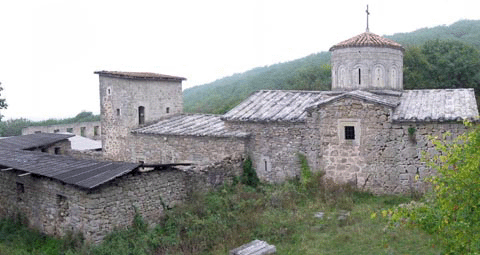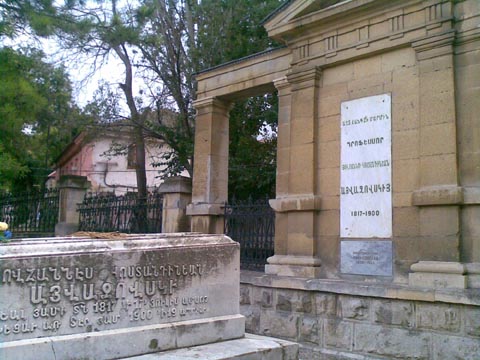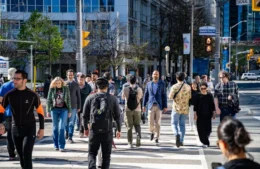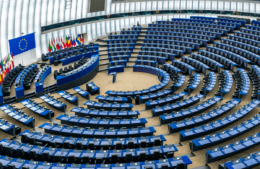Armenians in Crimea
- (0)
Armenians in Crimea –

Surb Khach Monastery is a medieval Armenian monastery located on the Crimean peninsula near Staryi Krym and founded in 1358. It has been an Armenian spiritual center and a place of pilgrimage for centuries.
In the 8th century, Crimea was a part of the Byzantine Empire, with Armenians, as its subjects, moving here from various cities of the empire. The region’s stability allowed them to achieve economic prosperity, uninterrupted even in the face of the Mongolian invasions.
Hardships in Armenia drove increasing number of Armenians to Crimea, with Armenians becoming the 2nd biggest ethnic group after Crimean Tatars. In 1475, Crimea became part of the Ottoman Empire, and Christian persecutions began. Despite the strengthening of Islam in the region, Armenian communities still existed in Kaffa, Karasubazar, Balaklava, Gezlev, Perekop and Surkhat. From 1778-1779, more than 22,000 Armenians were resettled in the Azov province.
In 1783, the Russian Empire conquered the Crimean khanate. Russian authorities encouraged the settlement of foreign colonists, including Armenians, into Crimea. This led to a fresh wave of Armenian immigrants, reviving former settlements. In 1913, their numbers totaled around 9,000 and 14,000-15,000 in 1914. The resettlement of Armenians in the peninsula lasted until the First World War and the Armenian Genocide in the Ottoman Empire in 1915-1923. The immigrants of the 19th and 20th centuries were largely from Western Armenia and the various regions of the Ottoman Empire.
In 1944, the Commissar of Internal Affairs of the Soviet Union, Lavrentiy Beria signed Directorate 5984 to deport 37,000 Bulgarians, Greeks and Armenians. The Armenians were deported to Perm Oblast, Sverdlovsk Oblast, Omsk Oblast, Kemerovo Oblast, Bashkortostan, Tatarstan and Kazakhstan.
In 1989, the communal life of Crimea’s Armenians was institutionalized with the formation of one of the peninsula’s first national-cultural associations, the Armenian Luys (Light) society. Later, after re-registration in 1996, it was renamed the Crimean Armenian Society. At present, the Crimean Armenian Society consists of 14 regional offices, coordinated by the National Council of Crimean Armenians. The highest governing body is the National Congress, which convenes at least once every four years. Operational management of the society is carried out by the executive committee, which functions in the periods between meetings of the National Council. The society operates the Luys cultural and ethnographic center and publishes a monthly newspaper, Dove Masis. The one-hour Armenian-language program Barev airs twice a month on Crimean television, and radio broadcasts are made five times a week. There are Armenian churches in Yalta, Feodosiya and Evpatoria, while the first Armenian secondary school opened in 1998 in Simferopol.
Armenians living in the Crimea are currently concentrated in the cities of Armyansk, Simferopol, Evpatoria, Feodosiya, Kerch, Yalta, Sevastopol, Sudak. The Armenia Diaspora Encyclopedia indicates that there were 20,000 Armenians living in the region in 2003.
One of Crimea’s most famous Armenians was painter Hovhannes Aivazovsky, renowned for his seascapes such as this one. ‘The Ninth Wave’ (1850)
The Armenians were mostly adherents of the Armenian Apostolic Church. There were a number of churches built in Yalta, Feodosiya and Yevpatoria. Construction activity took place from the 14th century and according to one manuscript the monastery of Gamchak had been built by the fifteenth century in Kafa.
In Kafa, there were a number of Armenian schools, dozens of churches, banks, trading houses, caravanserai, and craftshops. The town was served as a spiritual center for the Crimean Armenians, and its stature grew so prominently that that in 1438 the Armenians of Kafa were invited to send representatives to the Ferrara-Florence Cathedral (Florence ecumenical council).
The second largest Armenian population after Kafa in the same period was Surkhat. The name of Surkhat is probably a distorted form of the name of the Armenian monastery Surb Khach (Holy Cross). There were many Armenian churches, schools, neighborhoods here as well. Other major settlements included Sudak, where until the last quarter of the 15th century and near the monastery Surb Khach there was a small Armenian town called Kazarat. Armenian princes kept troops there and on a contractual basis to defend Kafa.
The social life of the Crimean Armenians surged in the late 19th and 20th centuries. They organized themselves into community organizations. Wealthy Armenians and the church tried to “raise” the nation to the level of modern civilization, and to carry out charitable activities. The source of money and material welfare of the church were grants, wills, and donations.
The church’s role in the colonies was to some extent becoming secularized. In 1842, the Catholicos in Crimea lost his position to the Chief Guardian of the Crimean Armenian churches.
Surb Khach Monastery is a medieval Armenian monastery located on the Crimean peninsula near Staryi Krym and founded in 1358. It has been an Armenian spiritual center and a place of pilgrimage for centuries.
Crimea gave the world many outstanding Armenians, including world-renowned painter Hovhannes Ayvazovsky, composers Alexander Spendiarov and Christopher Kara-Murza, and artist Vardges Sureniants.
At present, no significant outflow of Armenians from Crimea has been noted, with Armenians safe here, unlike in Syria. However, considering the unpredictability of the development of events in Ukraine, the possibility of a dangerous situation should not be ruled out.
PANARMENIAN

Aivazovsky’s grave in Feodosia
Armenian painter Ivan Aivazovsky spent his final years in Feodosia (Crimea) where, “He supplied the town with water from his own estate, opened an art school, began the first archaeological excavations in the region and built a historical museum. Due to his efforts a commercial port was established at Feodosia and linked to the railway network”.
Aivazovsky died on 19 April (2 May in New Style) 1900 in Feodosia. “In accordance with his wishes”, he was buried at the courtyard of St. Sargis Armenian Church. A white marble sarcophagus was made by Italian sculptor Լ. Biogiolli in 1901. A quote from Movses Khorenatsi’s History of Armeniain Classical Armenian is engraved on his tombstone: Մահկանացու ծնեալ անմահ զիւրն յիշատակ եթող (Mahkanatsu tsneal anmah ziurn yishatak yetogh),which translates: “He was born a mortal, left an immortal legacy”or “Born as a mortal, left the immortal memory of himself”.


















